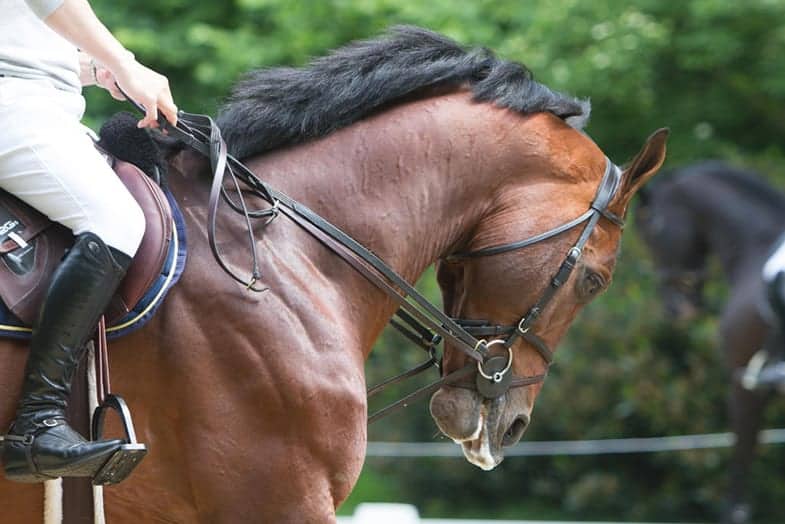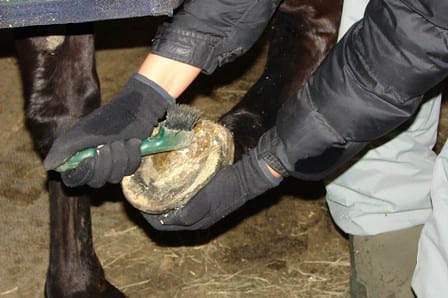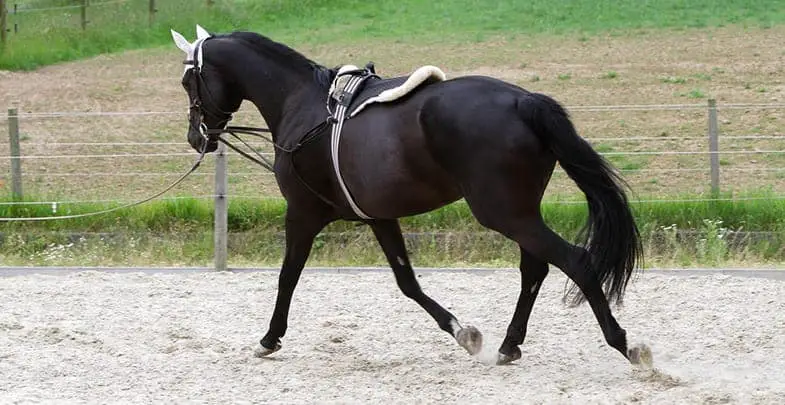We all know that it can be so easy, even if only just for a minute, to get angry with our horses and shout at them (or worse) but while it can be frustrating if your horse just won’t do what you want him to this is never the answer. Over the years I’ve learned a few different training methods that I thought would be a good idea to share with you. Not only do these methods work every time, but also they don’t involve any form of punishment at all.
Should you ever punish a horse? Punishing a horse will never work, regardless of the form of punishment you use. A horse won’t understand why you’ve just hit or kicked them, nor will they understand why you’re shouting so will become frightened and more likely to react negatively. Instead, reward your horse’s good behavior.
While it might make you feel better in the immediate moment, punishing your horse (regardless of whether you shout at them or hit them) will only be causing long-term problems for both you and the horse. On top of that, you’ll also be damaging the relationship you both have, sometimes irrevocably.
Put yourself in your horse’s shoes, how would you feel if you were in a bad mood or in pain (which made you irritable) and somebody shouted at you or hit you? Exactly! You wouldn’t want to do what they asked you to do, no matter how nicely they asked you after. At least you’d understand if they said sorry though but your horse wouldn’t.
Why you should never hit a horse
It doesn’t matter whether you hit your horse with your hand or with an object, the result will always be the same, and as a form of correction, it’ll never work. Your horse won’t understand why you’ve just hit him and will be more likely to fear you in the future which will only lead to even more behavioral issues as he becomes more fearful and rebellious.
While all forms of hitting a horse are bad and should be stopped immediately, hitting them around the head is the absolute worst. It’s likely to result in a head shy horse and anything that makes a horse throw his head up in fear will also make training much harder.
Your horse won’t associate your behavior with what he’s just done so hitting a horse that bites will make him more of a problem biter. After all, if he knows that you’ll hit him as soon as he bites he could end up biting people without warning, as he’ll think he has to ‘race’ you to get out of the way before you hit him.

Why kicking your horse will never work
To me kicking is just the same as hitting, except for the fact that you’re obviously using your legs/feet instead of your hands. It doesn’t matter if you kick your horse from the ground or while you’re riding it should never be done.
Punishing your horse by kicking him while riding won’t correct his behavior but will likely make it worse while possibly also making it harder for you to control him in the future. If you ride in spurs then it could also cause some serious damage to your horse if you repeatedly do this while wearing spurs.
Some people might argue that kicking a horse while riding is a spontaneous action but to my mind, there’s no way you could have considered kicking a horse while on the ground as anything but a deliberate act which is why I think it’s more akin to cruelty rather than poor training. After all, you have to take the time to get your balance then swing your leg back before swinging it forward to make contact with the horse.
Don’t pull on the reins as a form of punishment
You might not think that pulling on the reins is a negative act, let alone a form of punishment but it can still have a detrimental effect on your horse’s behavior and could even make him unsafe to ride.
By pulling on the reins as a way of stopping or correcting undesirable behavior will make your horse’s mouth sore and erode the trust he has in you. In extreme cases, it could even result in your horse fighting against your signals and completely ignoring them. In time this could turn your horse into a headshaker and make him very difficult to ride.

Pulling your horse’s head won’t correct his behavior
Like pulling on the reins, yanking, or pulling at your horse’s head (whether from his nose, poll, or just on the lead line) won’t fix any issues that you might be having with him and is far more likely to produce a head shy horse.
The same can be said for aggressively flicking the whip, lead line, or other objects near your horse’s head or face. This action will likely result in your horse taking a step backward to avoid what you’re doing. This backward motion, combined with the horse naturally flinching, will almost definitely cause your horse to raise his head and therefore heighten his fear.
Why you should never put a horse in solitary confinement
I’ve often heard people saying that they’ve tied their horse up on its own so that they can have some time to think about what they’ve done but this simply doesn’t work. Horses are only aware of what has just happened rather than what happened five minutes or an hour ago so he’s not going to stay there quietly thinking about what has happened.
Horses are extremely social animals so punishing them by putting them in a stall on their own will distress them which will only serve to heighten their anxiety and increase their fear, making the problem worse.
When you consider that we use solitary confinement as a form of extreme punishment for criminals (and even as a method of torture) why on earth would you use it on your horse? At least we understand what’s happening, even if we don’t like it, but there’s no way your horse would understand, let alone learn from the experience.
Restricting your horse’s movement never works

Tying your horse up so that he can’t move freely will cause a lot of sore muscles at best but it certainly won’t stop any negative behavior. Being prey animals, horses will need to at least feel as if they can easily escape if the situation arises but if you tie their heads so they can’t move they could very easily panic and seriously hurt themselves trying to get free.
Even if you’re only tying your horse’s leg up so that you can pick out his feet it’s still a big no-no. Instead, you should train your horse to allow you to lift his leg up, while this movement will still restrict his movement he won’t feel trapped because he chose to let you pick it up. And of course, he can put it back down again whenever he wants, even if you haven’t finished.
Why you shouldn’t encourage your horse to raise his head during training
I’ve talked a lot about punishing your horse and the consequences of doing so but one thing I haven’t talked about is why it’s a bad idea to do anything that makes your horse raise his head.
It’s not to say your horse should always keep his head as low to the ground as possible but when a horse raises his head, particularly when it’s higher than normal, it creates stress and tension in a horse. This happens because horses are grazing animals that are heavily predated in the wild, when their heads are down their relaxed, calm, and happy. If a horse senses any form of danger they’ll immediately raise their head so that they can better see if the threat is real. The trouble is that if the threat is real then the horse will have to flee, so the act of raising their head means that their body is automatically tensed readying them to run if necessary.
When you’re training your horse and do something that causes him to raise his head he won’t stop and think that he must have done something wrong. Instead, his instincts will kick in and he’ll tense his body in case he needs to escape the situation, this will only be reinforced further if you chastise him.
Six non-aggressive ways to discipline your horse
The best way to train any horse is to work with the horse rather than to force it to do something (or to stop doing something), but the only way we can do this properly is to understand them a bit better. While all horses are different no horse will act in a negative way without a reason, they may be frightened, frustrated, or in pain. If you know this you can begin to address the problem without having a negative impact on your horse in any way.
There are many forms of non aggressive training out there but below are the six methods that I always use.

1) Use your voice
You can use your voice to both reward your horse for doing the right thing and to let him know he’s done something wrong. You don’t need to shout at him or even raise your voice, a calm but firm ‘No’ will be more than enough to let him know he’s done something wrong, just so long as you do it straight away.
Shouting at your horse will just put him on edge and make him nervous which will mean he’s less likely to listen to you.
2) Body language
Horses use body language far more than any other form of communication so speaking to your horse in a way that he’ll understand is going to be far more effective. Instead of chastising your horse for doing something wrong simply stand tall and squarely in front of him and look him in the eyes. Doing this will let your horse know you’re in charge and what he just did was wrong, but it’s important that you relax your posture as soon as your horse responds positively to you.

3) Back up
While this won’t always work (especially if your horse has just bitten somebody) it will if your horse is being bossy and trying to dominate you. The reason this works is that you’re switching the control from your horse back to you while also letting your horse know you’re the leader.
To do this you should apply a little bit of pressure on your horse’s chest (either with your hand or, if he doesn’t move straight away, with your upper body) and slowly step him backward. This forces him to give you his attention but also adjusts his balance so that he can no longer try to push you around.
4) Be calm and consistent
While this isn’t really a training method it is something that you should always keep in mind when you’re working with your horse. This is because horses are flight animals that rely on each other for their survival, if you’re on edge and tense your horse will sense that and mirror that behavior. Likewise, if you’re calm and relaxed your horse will feel safe and happier around you and will therefore respond positively.
The reason consistency is important is that, although we might not always realize it, horses really do try and do what we ask them but if you’re not consistent your horse will get confused and frustrated. While this might not seem like a problem at first it can lead to problems further down the line.
5) Work on your horse’s terms
You’re always going to get better results if your horse is happy, alert, and paying attention to you which is why you should work at your horse’s pace. If he looks like he’s getting bored or confused don’t force him to carry on. It may take longer but you’ll get far better and longer-lasting results.
It’s also advisable to end on a positive note, no matter how small it is, your horse will remember the training session positively and will be more willing next time.

6) Positive reinforcement training
Regardless of whether or not you use any of the training methods above you really should be using this one, it’s by far the most rewarding (for both you and your horse) and gives the best results. After all the best way to correct a horse’s bad behavior, whatever it is, is to reward him when he does the right thing and positive reinforcement training does exactly that.
By praising your horse for doing things well and behaving properly you’re creating a relaxed and positive environment for him. This, in turn, will mean that he’ll be far more likely to respond to your commands and do what you ask without misbehaving.
Related questions
Am I okay to chase my horse to catch to them?
While you shouldn’t let your horse get away without being caught, chasing him around the field will never work. Horses are a lot faster than us so will easily get away but you could also be inadvertently teaching your horse to run away from you. Instead, be patient and approach him slowly from the side or in front, don’t try and catch him from behind.
Does using a whip hurt the horse?
If you use a whip correctly then it won’t hurt your horse but if you don’t use it properly, or use it excessively, then there’s every chance you could be harming your horse. Despite a horse having relatively though skin, using a whip incorrectly could cause bruising and inflammation.
Further reading
- What does it mean if a horse follows you?
- How often should you ride your horse?
- Bonding with your horse without riding
- Why is my horse pawing at the ground?
- How to stop your horse rearing
- Train your horse to load successfully
- How to improve your horse’s confidence
- Why do horses show their teeth?
- Common horse sounds & what they mean
- How to deal with an aggressive horse
I hope you found this article helpful. If you did I’d be grateful if you could share it please as it would really help me.
Recommended products
Over the years I have tried hundreds of different horsey products, from various blankets and halters to different treats. Some I’ve loved, others I’ve hated but I thought I’d share with you my top all-time favorite products, the ones I never leave the yard without. I’ve included links to the products (which are in no particular order) that I really think are great.
- Horse Knots by Reference Ready – If you’re like me and enjoy pocket reference guides then you’ll love this knot tying guide. These handy cards can easily fit in your pocket or attach to the saddle for quick reference. They’re waterproof, durable and are color coded to make them easy to follow.
- Mane ’n Tail Detangler – Even if you never show your horse you’ll need to detangle his tail from time to time (and possibly his mane too) which is always a challenging chore! I’ve found that if I run a little bit of detangler through my horse’s tails every few days it stops them from getting matted up and makes combing them easy, even if they’re coated in mud. I don’t know if I should admit to this or not but it also works wonders on my hair.
- TAKEKIT Pro clippers – Over the years I’ve tried a lot of different clippers and while some were obviously better than others I found these to be by far the best. They are heavier than a lot of other clippers but for me, that’s a good thing, it makes them feel more sturdy and hardwearing. On top of that they have a range of speeds so are just as good for clipping your horse’s back as they are his face. I also like the fact that they come in a handy carry case but that’s not for everybody. The company that makes them is super good and incredibly helpful too, a real bonus these days. The only thing I wasn’t keen on was the fact that it doesn’t come with any oil, but that’s not a major problem as it’s not difficult to buy lubricant.
- Shire’s ball feeder – There are so many boredom buster toys out there but I like to use these every day, regardless of whether or not my horses are bored. I find that it helps to encourage my horses to problem solve by rewarding them with treats (or pieces of fruit) but it also mimics their natural grazing behavior which helps to keep them calm and de-stressed.
- Horse safe mirror – This is a strange one that many people are surprised about but I like to put horse safe mirrors in the trailers as well as in the quarantine stalls. It helps to prevent the feeling of isolation by giving the impression of other horses being around. Being herd animals horses can get extremely stressed when they feel that they’re on their own but with these stick-on mirrors, they believe that at least one other horse is with them.
- Rectal thermometer – I know this isn’t glamourous at all but it’s vital for your horse’s well-being to be able to check their temperature and a rectal thermometer is the easiest way of doing this which is why I’ve added it to the list.
Shopping lists
I’ve also put together a few shopping lists of essential items that I’ve found helpful over the years. I’ve broken the lists down into different categories rather than put everything in one massive list 😉
